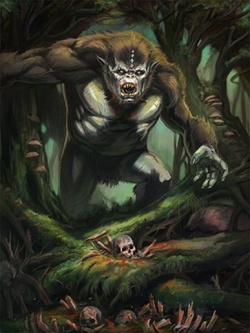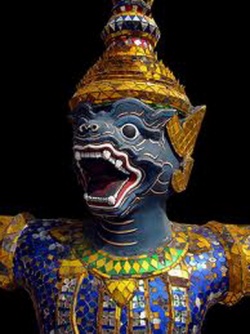Yakshas
- See also :
- See also :
Yakshas, the ancient aboriginal tribe of Kashmir, who dwelled in the upper mountainous region of the Himalayan ranges extending from the present day Uttranchal, Himachal Pradesh to Kashmir.
The Hindu scriptures have elevated Yakshas to the status of demigods along with Gandharvas (the celestian musicians), Kinnaras (the divine choristers), Kiraats and Rakshas.
The Yakshapati Lord Kubera is regarded as an intimate friend of Lord Shiva.
Lord Kubera, known as the Lord of wealth, is said to be the son of sage Visravas and grandson of the sage Pulastya besides being the half brother of the demon king, Ravana.
As per the Hindu mythology, Lord Kubera resides in the mythological city of Alkapuri, which is said to be situated on one of the spurs of the Mount Meru in the exalted Himalayas.
Incidentally, Mount Meru, which is believed to be densely forested with the divine 'Kalpavraksha' trees is said to be the abode of Lord Shiva also. Alkapuri is also known by the names of Vasudhara, Vasusathli and Prabha.
As per the Hindu epics of Ramayana and Mahabharat, Lord Kuber had his sway on the city of Lanka before he was ousted from there by his half brother, the demon king Ravana.
He was also the proud owner of the celestial aerial chariot 'Pushpak Viman', which was later-on snatched away from him by the demon king Ravana.
The city of Lanka is believed to have been built of gold by the divine architect Vishwakarma for the residence of Lord Kubera.
Yakshi also known by the alternative names of Charvi and Kauveri, the spouse of Lord Kubera is said to be the daughter of Danav Mura.
She is believed to serve Goddess Durga as one of the attendants.
Manigriva (also known as Varnkavi) and Nalkubera (also called as Mayuraja), are Lord Kubera's sons, whileas Menakshi is his daughter.
Lord Kubera, the King of Yakshas is also known as Dhanpati (the lord of wealth), Nar-raja (the King of men), Rajraja (the King of Kings), Ichchhavasu (one who gets immense wealth at his own wish and will), Ratangarbha (one who possesses plenty of jewels and diamonds) and also as Rakshasendra (the chief of demons).
He is also known as the presiding deity of the northern side of the universe and the house.
Hindu mythology describes Kuber to have a white complexion, a deformed body with three legs and only eight teeth.
Further, he is regarded not only as the lord of gold but also of silver, jewels, diamonds and all other kinds of precious stones.
He is also known as the protector of the business class of the society.
In the mythological depictions, Lord Kuber is shown as seated on the shoulders of a man or riding a carriage pulled by men.
Sometimes an elephant or a ram (an uncastrated male sheep) are also shown as his mounts.
The subjects and devotees of Lord Kuber are called as Yaksh and they are believed to possess supernatural powers.
They can change their shape and form at will. They are regarded to be full of kindness, compassion and benevolence.
According to Kalhan's Raj Tarangni, Yakshas resided on the mighty mountain ranges of Kashmir.
They would descend to the plains during the winter season, where the Naga inhabitants would extend the hospitality to them by offering the delectable cuisine of Khichdi.
The Yakshas are believed to be historical reality down the ages as innumerable villages and temples have been dedicated to them.
They exist in vast stretches of land right from the present day states of Uttranchal, Himachal Pradesh and Jammu and Kashmir.
In the capital city of Shimla in Himachal Pradesh, there is a famous Hanuman temple on the adjacent Jakhu hill.
It is believed that thousands of years back Yaksha sage performed austerities and penance there. Lord Hanuman is said to have made a brief stopover at the Jakhu hill during his search for 'Sanjeevani Bhooti' for Lakshman.
The sage Yaksha latter-on built a temple on the hill in honour of Lord Hanuman.
In Rohru and Arki tehsil of Shimla district, two villages dedicated to Yakshas are known by the names of Jakhu and Jakhol.
The word Jakhol in the local dialect means 'Yakshalai' or the abode of Yaksha.
In the central part of Himachal Pradesh, there are many temples dedicated to Yakshas and Yakshanis, who are worshipped as the village deities of the natives.
They are also regarded as the deities of domestic cattle. In order to ward off the evil spell and to guarantee plentiful of milk, Yakshas are propitiated by burning 'dhoop' and incense sticks in the cowsheds.
Dr. M.S. Randhawa, a noted researcher writes in his book "Farmers of India" that Pischas, Yakshas and Naga tribes inhabited Kashmir in ancient times.
Prof. DD Sharma, a well-known historian and researcher has identified numerous villages dedicated to Yakshas in the hilly regions of the Himalayas in his book "Himalayan Sanskriti Kae Muladar".
There is a strong belief among the people in the hilly areas that affluence and fortune will come one's way if the Yaksha King Lord Kuber is propitiated and pleased. The said belief also exists in the folklore of Kashmir.
According to Prof. D.D. Sharma, the villages of Jakh, Jakhet in Karanprayag, Jakhola in Joshimath, Jakhni and Jakhoal in Chamoli, Jakhand, Jakhanyali, Jakhvadi, Jakholi, Jakhni and Jakhi in Devprayag, Jakh and Jakhol in Tehri Garhwal, Jakh, Jakhni, Jakhola and Jakhmoli in Pauri Garwal and Jakhu on Dehradun-Rajpora road not only had strong association with Yakshas but also speak volumes about their possible high concentration in these places in the ancient times.
In addition to it, the entire area of Alaknanda right from Joshimath to Karanprayag is known as 'Jakh' or the area which was once occupied and dominated by Yakshas.
According to Dr. Jagdish Prasad Samval, a celebrated researcher, a temple known as 'Yakshraj' exists on a mountain top about one km. away from Narayankote on the road leading to Kedarnath.
Yakshraj, Lord Kuber is the local deity of the surrounding eleven villages of the area.
Likewise, there is a Yakshraj temple in Pithoragarh also, where meat offerings are made to the deity.
Yakshraj is also the guardian deity of the adjacent villages. Almora also has a famous temple known as Jakhani Devi temple.
According to Prof. D.D. Sharma, Almora area has Jakhnola, Jakhnoli, Jakhani, Jakh villages, whileas Ranikhet has Jakhni, Jakh and Nainital has the village by the name of Jakh.
In Jammu province also there are two villages-Jakhni (65 kms from Jammu city on way to Udhampur) and Jakhbhar (4-5 kms from Kathua on Nagari road).
In Kashmir also, the Yakshas have left their impressions behind.
These have survived in the form of village names even upto the present times.
The villages of Ichikote, Ichigam, Ichihama, Ichigoz and Rairyach situated in the central district of Budgam (Kashmir) might have been Yaksha settlements at certain stages of time.
I have also been able to locate one more village by the name of Yachihoum, which is nestled in the foothills of forested mountain on Srinagar - Sonamarg road in Ganderbal district in Kashmir.
One more village known by the name of Yachinar is situated in the southern district of Anantnag in Kashmir.
According to Late Prof. Laxmidhar Kalla, a noted Sanskrit scholar of India and HoD Sanskrit, Delhi University, a village by the name of Alkapuri exists near the village Manigam in Ganderbal (Kashmir).
Some scholars state that a tribe by the name of Yakshun lives in Dardistan area, which is located in north of Kashmir.
They assert that the name Yakshun is a derivative from Yakshkun meaning Yakshas.
A township to the west of the present day new airport near Humhama village in Budgam village locally known as Damodar Wudar is said to have been built by an ancient King of Kashmir, Damodar.
Yakshas, who were adept in the construction skills are believed to have contributed help and expertise.
Yakshas have also left their imperishable imprints on the social fabric of Kashmir.
They are in the form of Surnames of 'Yaksha', 'Yach' and 'Rakshas' retained by Kashmiri Pandits.
Lord Kuber is said to be the chief of both Yakshas and Rakshas.
Late Sh. Dina Nath Yaksh, a noted Sanskrit scholar of Kashmir was a resident of Bulbullankar, Alikdal Srinagar upto the year 1990.
About five to six Pandit families having the surname 'Yach' were residents of Rainawari (Karapora Khushki) area in Srinagar upto their migration from there in 1990.
A few Pandit families with the surname 'Yach' were also residents of Karfalli-Mohalla, Srinagar and Sopore township of Baramulla district. According to few Hindu scriptures 'Rakshshas' are not demons but on the contrary benefactors and defenders.
According to Kashmiri folklore, Yaksh is believed to make two and half sounds of 'Waaf' (two high pitched and one low volume sounds).
The same folklore says that Yaksh dons a red cap made of gold, which is studded with jewels and diamonds.
This cap known as 'Phous' is said to bestow enormous supernatural powers to Yaksh.
As per prevalent lore in Kashmir, anyone who succeeds in snatching the cap and then hides it under a mortar or a hand mill stone or a pitcher filled with water or an earthen pot full of fermented kitchen leftover vegetables called 'Saderkanz' is believed to tame Yaksh.
The snatcher is given unlimited wealth if the cap is given back to Yaksh.
According to family lore of Ambardars, one of their ancestors is believed to have seized the cap of Yaksh.
After the cap was returned to Yaksh, the Ambardar families were exempted from offering the oblation of Khitchdi to Yaksh on the ritual of Khitchdiamavsya.
The same family lore states that once one of their ancestors, who in violation of this exemption dared to observe the ritual of Khitchdiamavsya had his house engulfed by fire. Since that time the Ambardar families of Kashmir continue to abstain from observing the said ritual.


